engine TOYOTA AYGO 2021 Owners Manual
[x] Cancel search | Manufacturer: TOYOTA, Model Year: 2021, Model line: AYGO, Model: TOYOTA AYGO 2021Pages: 546, PDF Size: 81 MB
Page 503 of 546
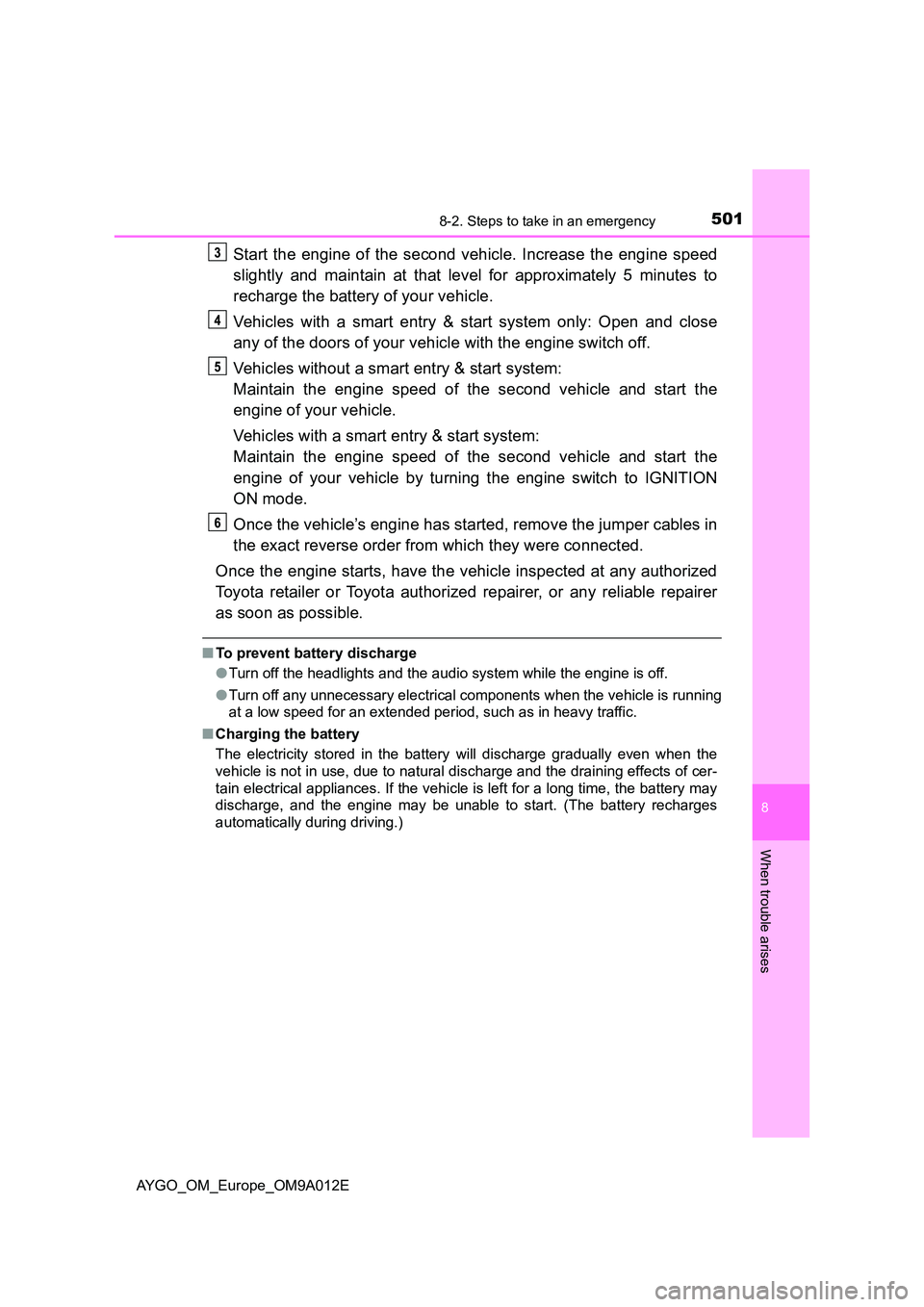
5018-2. Steps to take in an emergency
8
When trouble arises
AYGO_OM_Europe_OM9A012E
Start the engine of the second vehicle. Increase the engine speed
slightly and maintain at that level for approximately 5 minutes to
recharge the battery of your vehicle.
Vehicles with a smart entry & start system only: Open and close
any of the doors of your vehicle with the engine switch off.
Vehicles without a smart entry & start system:
Maintain the engine speed of the second vehicle and start the
engine of your vehicle.
Vehicles with a smart entry & start system:
Maintain the engine speed of the second vehicle and start the
engine of your vehicle by turning the engine switch to IGNITION
ON mode.
Once the vehicle’s engine has started, remove the jumper cables in
the exact reverse order from which they were connected.
Once the engine starts, have the vehicle inspected at any authorized
Toyota retailer or Toyota authorized repairer, or any reliable repairer
as soon as possible.
■ To prevent battery discharge
● Turn off the headlights and the audio system while the engine is off.
● Turn off any unnecessary electrical components when the vehicle is running
at a low speed for an extended period, such as in heavy traffic.
■ Charging the battery
The electricity stored in the battery will discharge gradually even when the
vehicle is not in use, due to natural discharge and the draining effects of cer-
tain electrical appliances. If the vehicle is left for a long time, the battery may
discharge, and the engine may be unable to start. (The battery recharges
automatically during driving.)
Page 504 of 546
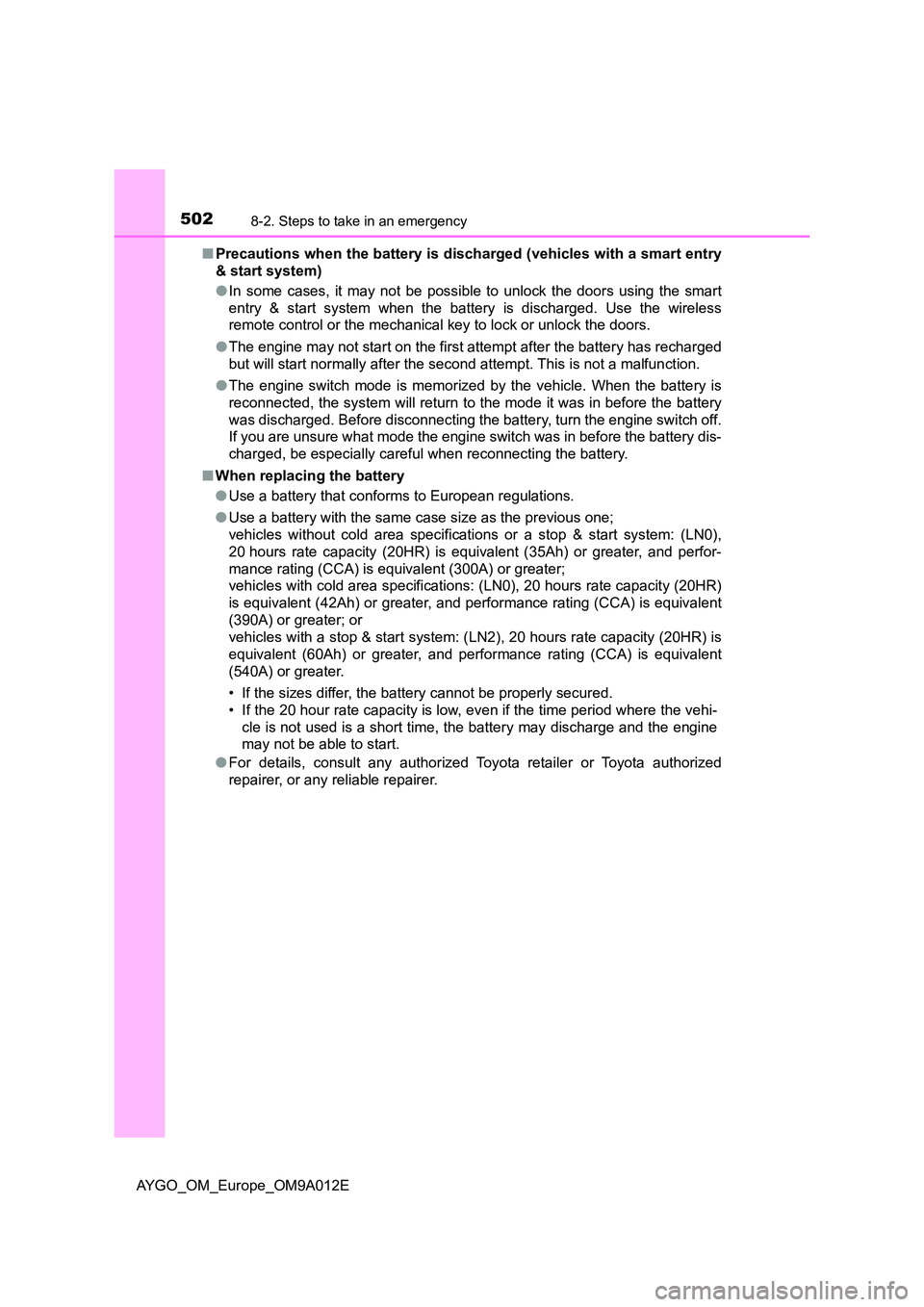
5028-2. Steps to take in an emergency
AYGO_OM_Europe_OM9A012E
■ Precautions when the battery is discharged (vehicles with a smart entry
& start system)
● In some cases, it may not be possible to unlock the doors using the smart
entry & start system when the battery is discharged. Use the wireless
remote control or the mechanical key to lock or unlock the doors.
● The engine may not start on the first attempt after the battery has recharged
but will start normally after the second attempt. This is not a malfunction.
● The engine switch mode is memorized by the vehicle. When the battery is
reconnected, the system will return to the mode it was in before the battery
was discharged. Before disconnecting the battery, turn the engine switch off.
If you are unsure what mode the engine switch was in before the battery dis-
charged, be especially careful when reconnecting the battery.
■ When replacing the battery
● Use a battery that conforms to European regulations.
● Use a battery with the same case size as the previous one;
vehicles without cold area specifications or a stop & start system: (LN0),
20 hours rate capacity (20HR) is equiva lent (35Ah) or greater, and perfor-
mance rating (CCA) is equivalent (300A) or greater;
vehicles with cold area specifications: (LN0), 20 hours rate capacity (20HR)
is equivalent (42Ah) or greater, and performance rating (CCA) is equivalent
(390A) or greater; or
vehicles with a stop & start system: (LN2), 20 hours rate capacity (20HR) is
equivalent (60Ah) or greater, and performance rating (CCA) is equivalent
(540A) or greater.
• If the sizes differ, the battery cannot be properly secured.
• If the 20 hour rate capacity is low, even if the time period where the vehi-
cle is not used is a short time, the battery may discharge and the engine
may not be able to start.
● For details, consult any authorized Toyota retailer or Toyota authorized
repairer, or any reliable repairer.
Page 505 of 546
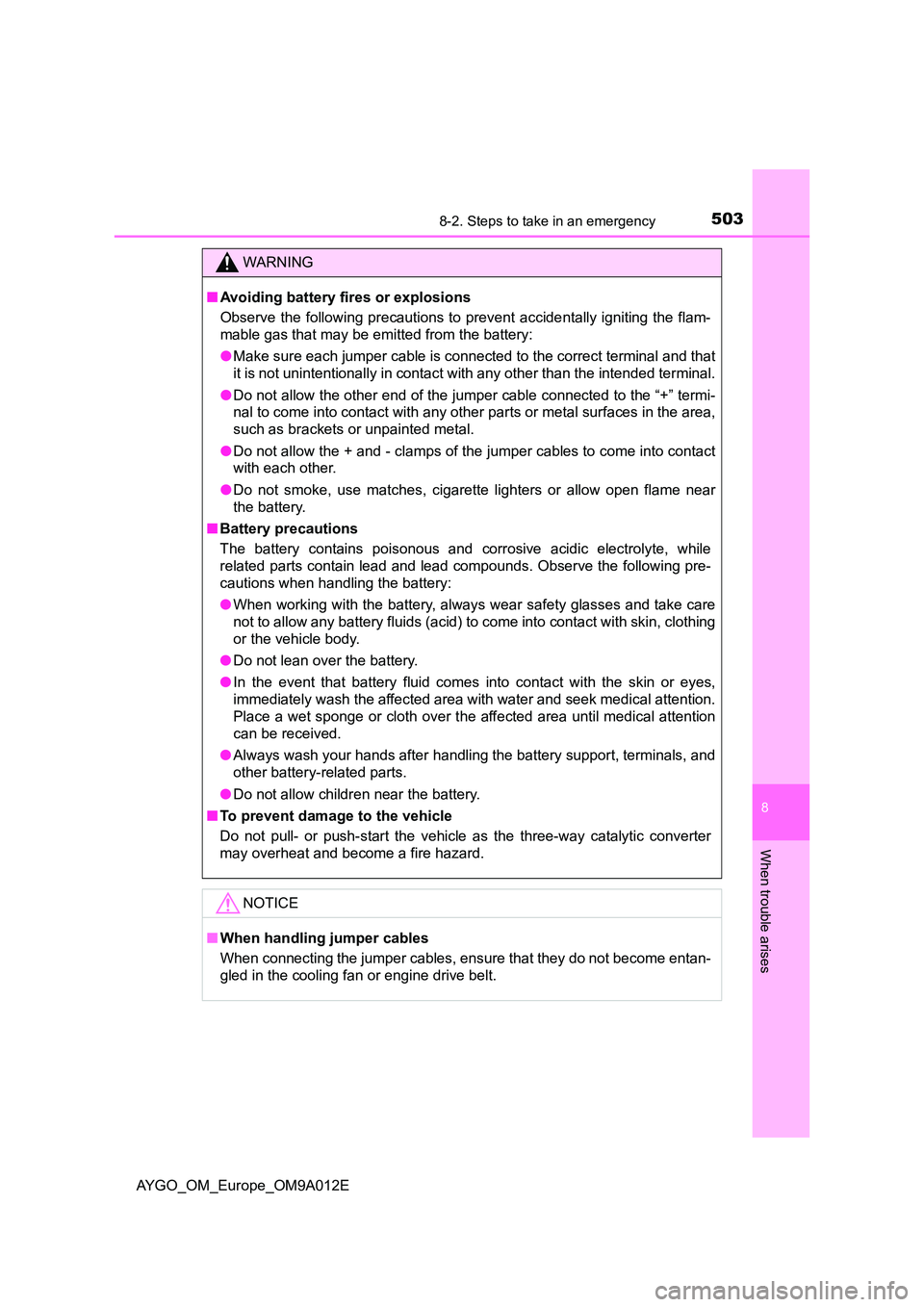
5038-2. Steps to take in an emergency
8
When trouble arises
AYGO_OM_Europe_OM9A012E
WARNING
■Avoiding battery fires or explosions
Observe the following precautions to prevent accidentally igniting the flam-
mable gas that may be emitted from the battery:
● Make sure each jumper cable is connected to the correct terminal and that
it is not unintentionally in contact with any other than the intended terminal.
● Do not allow the other end of the jumper cable connected to the “+” termi-
nal to come into contact with any other parts or metal surfaces in the area,
such as brackets or unpainted metal.
● Do not allow the + and - clamps of the jumper cables to come into contact
with each other.
● Do not smoke, use matches, cigarette lighters or allow open flame near
the battery.
■ Battery precautions
The battery contains poisonous and corrosive acidic electrolyte, while
related parts contain lead and lead compounds. Observe the following pre-
cautions when handling the battery:
● When working with the battery, always wear safety glasses and take care
not to allow any battery fluids (acid) to come into contact with skin, clothing
or the vehicle body.
● Do not lean over the battery.
● In the event that battery fluid comes into contact with the skin or eyes,
immediately wash the affected area with water and seek medical attention.
Place a wet sponge or cloth over the affected area until medical attention
can be received.
● Always wash your hands after handling the battery support, terminals, and
other battery-related parts.
● Do not allow children near the battery.
■ To prevent damage to the vehicle
Do not pull- or push-start the vehicle as the three-way catalytic converter
may overheat and become a fire hazard.
NOTICE
■ When handling jumper cables
When connecting the jumper cables, ensure that they do not become entan-
gled in the cooling fan or engine drive belt.
Page 506 of 546
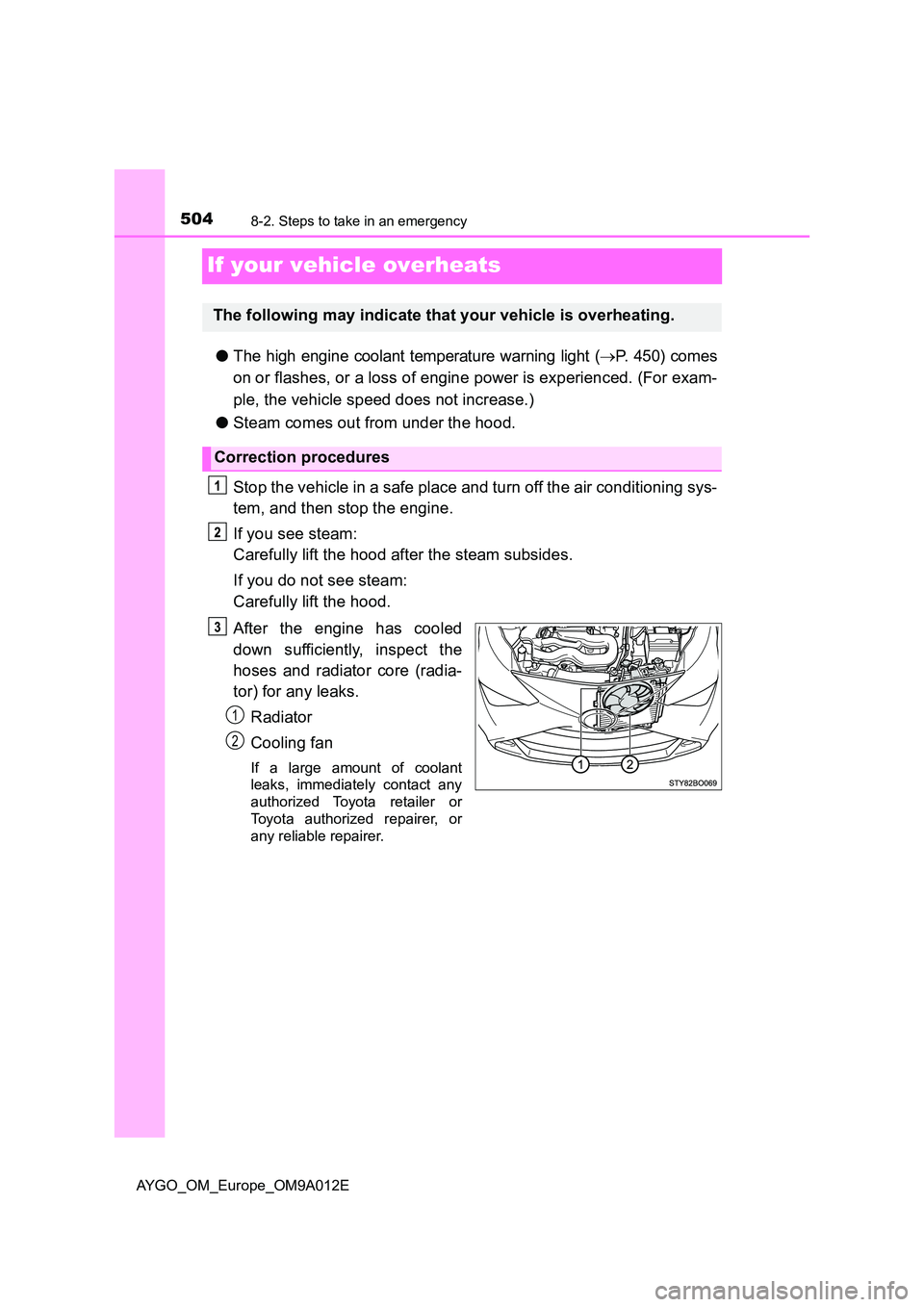
5048-2. Steps to take in an emergency
AYGO_OM_Europe_OM9A012E
If your vehicle overheats
●The high engine coolant temperature warning light (P. 450) comes
on or flashes, or a loss of engine power is experienced. (For exam-
ple, the vehicle speed does not increase.)
● Steam comes out from under the hood.
Stop the vehicle in a safe place and turn off the air conditioning sys-
tem, and then stop the engine.
If you see steam:
Carefully lift the hood after the steam subsides.
If you do not see steam:
Carefully lift the hood.
After the engine has cooled
down sufficiently, inspect the
hoses and radiator core (radia-
tor) for any leaks.
Radiator
Cooling fan
If a large amount of coolant
leaks, immediately contact any
authorized Toyota retailer or
Toyota authorized repairer, or
any reliable repairer.
The following may indicate that your vehicle is overheating.
Correction procedures
1
2
Page 507 of 546
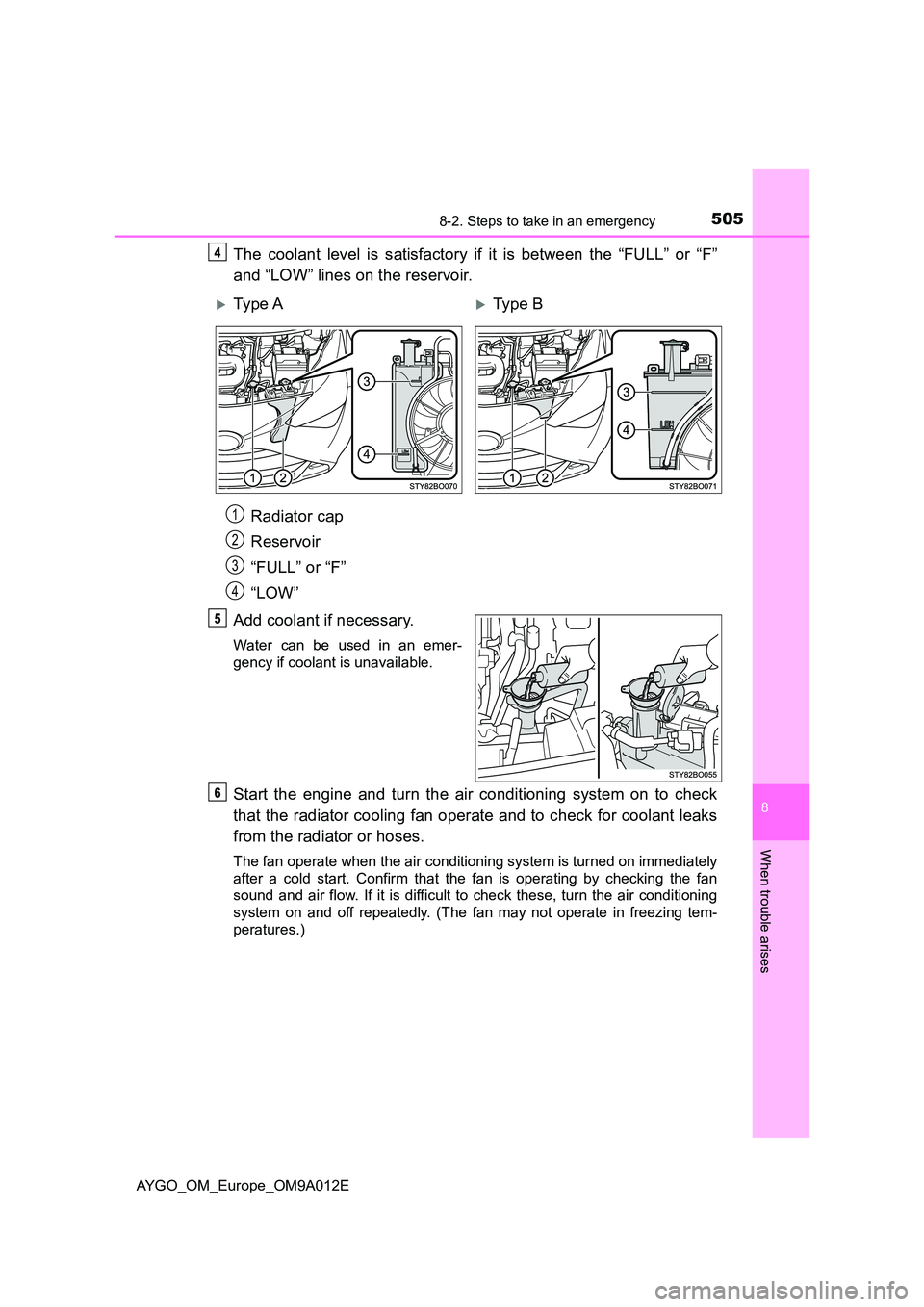
5058-2. Steps to take in an emergency
8
When trouble arises
AYGO_OM_Europe_OM9A012E
The coolant level is satisfactory if it is between the “FULL” or “F”
and “LOW” lines on the reservoir.
Radiator cap
Reservoir
“FULL” or “F”
“LOW”
Add coolant if necessary.
Water can be used in an emer-
gency if coolant is unavailable.
Start the engine and turn the air conditioning system on to check
that the radiator cooling fan operate and to check for coolant leaks
from the radiator or hoses.
The fan operate when the air conditioning system is turned on immediately
after a cold start. Confirm that the fan is operating by checking the fan
sound and air flow. If it is difficult to check these, turn the air conditioning
system on and off repeatedly. (The fan may not operate in freezing tem-
peratures.)
Ty pe ATy pe B
1
2
3
4
Page 508 of 546
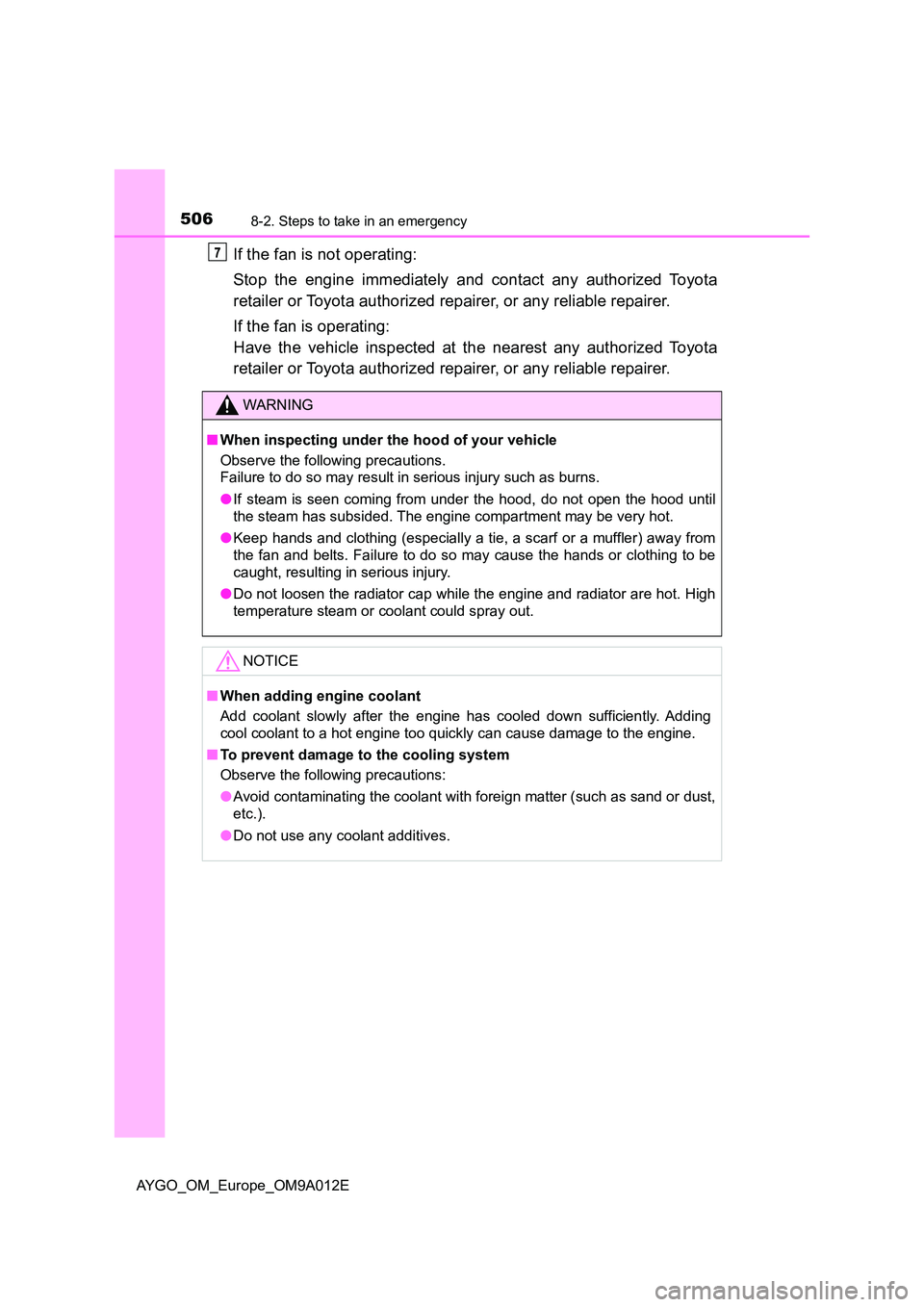
5068-2. Steps to take in an emergency
AYGO_OM_Europe_OM9A012E
If the fan is not operating:
Stop the engine immediately and contact any authorized Toyota
retailer or Toyota authorized repairer, or any reliable repairer.
If the fan is operating:
Have the vehicle inspected at the nearest any authorized Toyota
retailer or Toyota authorized repairer, or any reliable repairer.
WARNING
■ When inspecting under the hood of your vehicle
Observe the following precautions.
Failure to do so may result in serious injury such as burns.
● If steam is seen coming from under the hood, do not open the hood until
the steam has subsided. The engine compartment may be very hot.
● Keep hands and clothing (especially a tie, a scarf or a muffler) away from
the fan and belts. Failure to do so may cause the hands or clothing to be
caught, resulting in serious injury.
● Do not loosen the radiator cap while the engine and radiator are hot. High
temperature steam or coolant could spray out.
NOTICE
■ When adding engine coolant
Add coolant slowly after the engine has cooled down sufficiently. Adding
cool coolant to a hot engine too quickly can cause damage to the engine.
■ To prevent damage to the cooling system
Observe the following precautions:
● Avoid contaminating the coolant with foreign matter (such as sand or dust,
etc.).
● Do not use any coolant additives.
Page 509 of 546

5078-2. Steps to take in an emergency
8
When trouble arises
AYGO_OM_Europe_OM9A012E
If the vehicle becomes stuck
Stop the engine. Set the parking brake and shift the shift lever to N.
Remove the mud, snow or sand from around the stuck tire.
Place wood, stones or some other material to help provide traction
under the tires.
Restart the engine.
Shift the shift lever to E, M or R (multi-mode manual transmission)
or 1 or R (manual transmission) and release the parking brake.
Then, while exercising caution, depress the accelerator pedal.
■ When it is difficult to free the vehicle
Press to turn off TRC.
Turn off TRC and/or VSC if these functions are hampering your attempts to
free the vehicle. ( P. 280)
■ Emergency hooks
Carry out the following procedures if the tires spin or the vehicle
becomes stuck in mud, dirt or snow:
When your vehicle becomes stuck and
cannot move, the emergency hooks are
used for another vehicle to pull your
vehicle to pull your vehicle out in an
emergency.
Your vehicle is not designed to tow
another vehicle.
Page 514 of 546
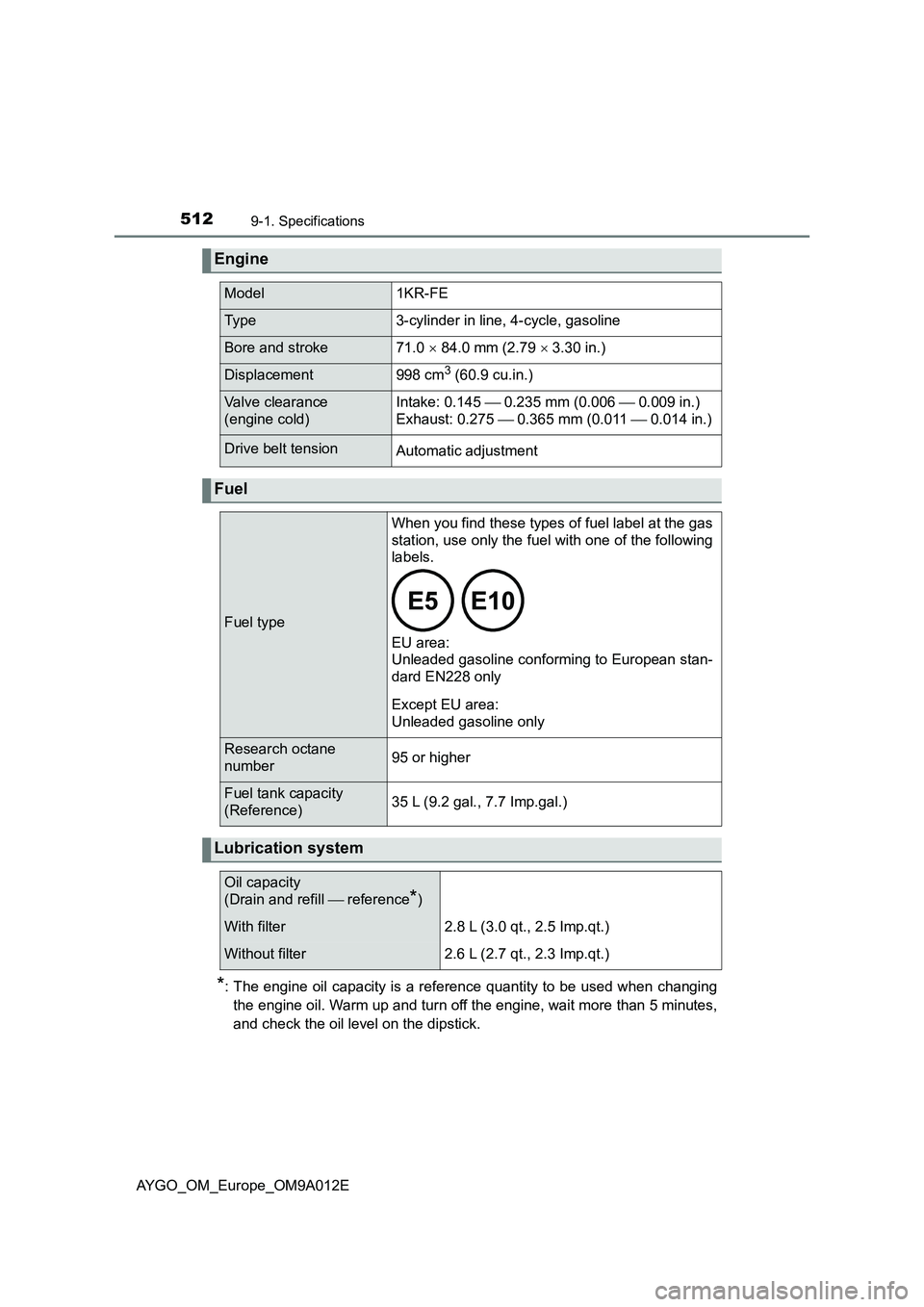
5129-1. Specifications
AYGO_OM_Europe_OM9A012E
*: The engine oil capacity is a reference quantity to be used when changing
the engine oil. Warm up and turn off the engine, wait more than 5 minutes,
and check the oil level on the dipstick.
Engine
Model1KR-FE
Ty p e3-cylinder in line, 4-cycle, gasoline
Bore and stroke71.0 84.0 mm (2.79 3.30 in.)
Displacement998 cm3 (60.9 cu.in.)
Valve clearance
(engine cold)Intake: 0.145 0.235 mm (0.006 0.009 in.)
Exhaust: 0.275 0.365 mm (0.011 0.014 in.)
Drive belt tensionAutomatic adjustment
Fuel
Fuel type
When you find these types of fuel label at the gas
station, use only the fuel with one of the following
labels.
EU area:
Unleaded gasoline conforming to European stan-
dard EN228 only
Except EU area:
Unleaded gasoline only
Research octane
number95 or higher
Fuel tank capacity
(Reference)35 L (9.2 gal., 7.7 Imp.gal.)
Lubrication system
Oil capacity
(Drain and refill reference
*)
With filter2.8 L (3.0 qt., 2.5 Imp.qt.)
Without filter2.6 L (2.7 qt., 2.3 Imp.qt.)
Page 515 of 546
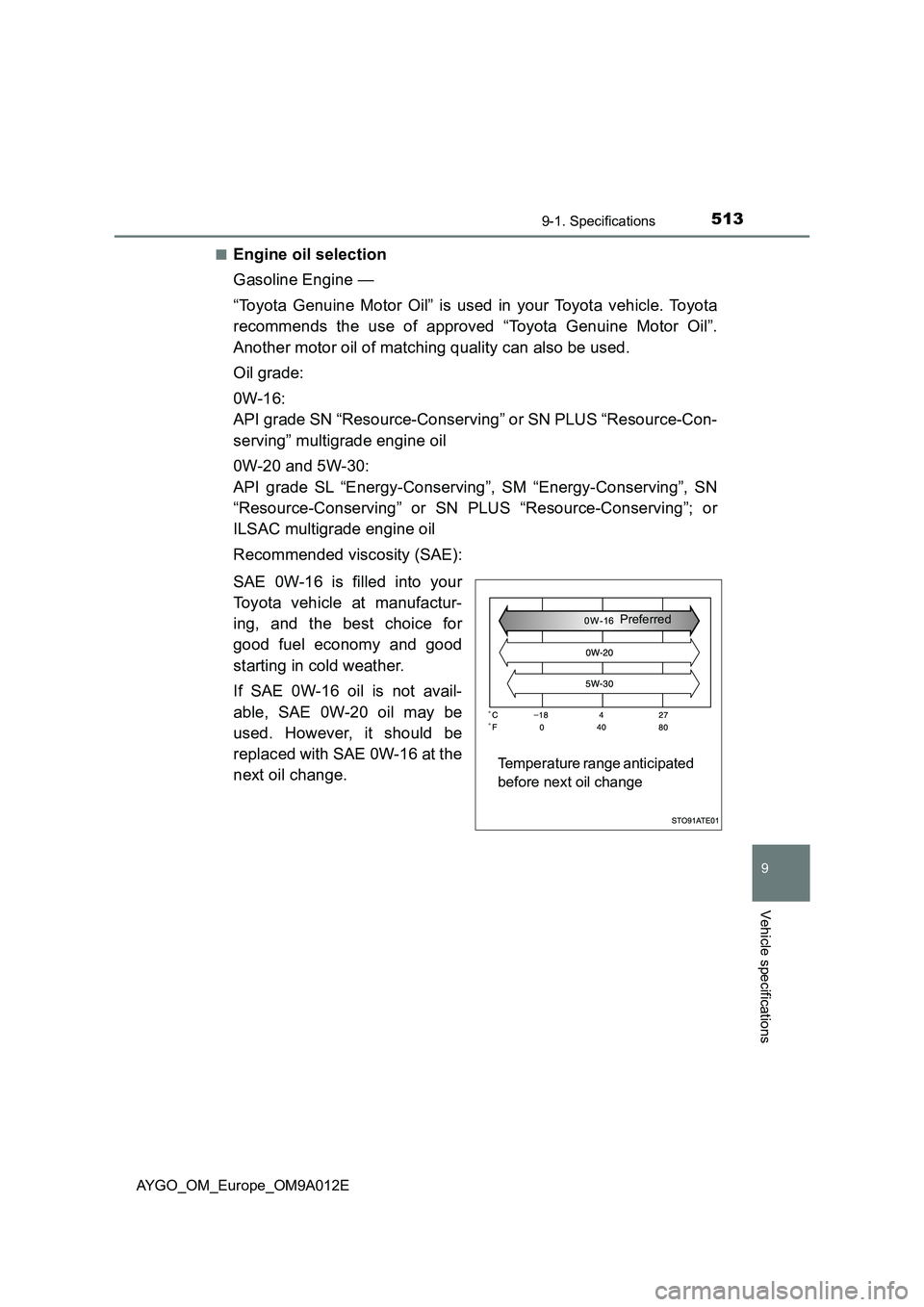
5139-1. Specifications
9
Vehicle specifications
AYGO_OM_Europe_OM9A012E■
Engine oil selection
Gasoline Engine —
“Toyota Genuine Motor Oil” is used in your Toyota vehicle. Toyota
recommends the use of approved “Toyota Genuine Motor Oil”.
Another motor oil of matching quality can also be used.
Oil grade:
0W-16:
API grade SN “Resource-Conserving” or SN PLUS “Resource-Con-
serving” multigrade engine oil
0W-20 and 5W-30:
API grade SL “Energy-Conserving”, SM “Energy-Conserving”, SN
“Resource-Conserving” or SN PLUS “Resource-Conserving”; or
ILSAC multigrade engine oil
Recommended viscosity (SAE):
SAE 0W-16 is filled into your
Toyota vehicle at manufactur-
ing, and the best choice for
good fuel economy and good
starting in cold weather.
If SAE 0W-16 oil is not avail-
able, SAE 0W-20 oil may be
used. However, it should be
replaced with SAE 0W-16 at the
next oil change.
Temperature range anticipated
before next oil change
Preferred
Page 516 of 546
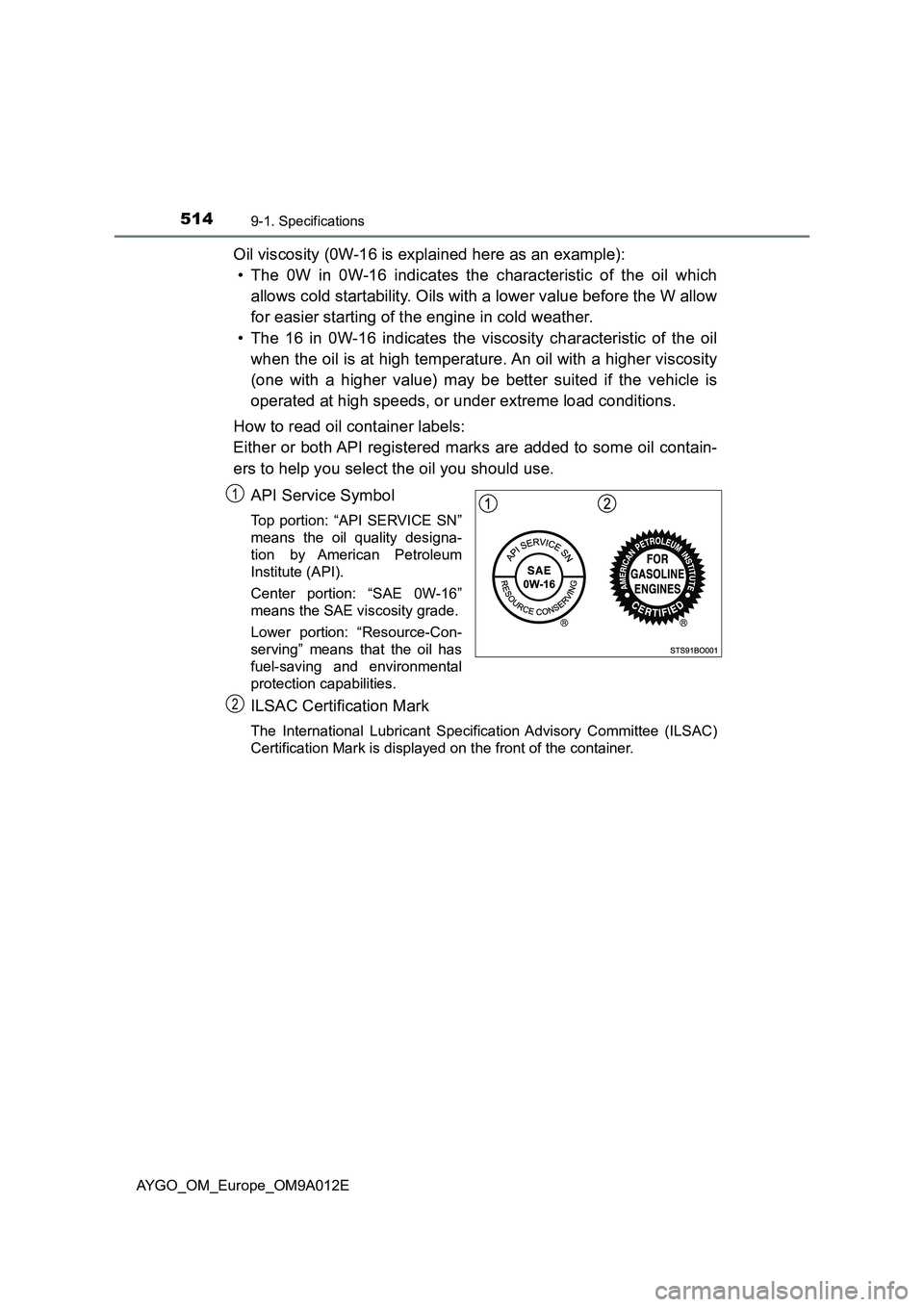
5149-1. Specifications
AYGO_OM_Europe_OM9A012E
Oil viscosity (0W-16 is explained here as an example):
• The 0W in 0W-16 indicates the characteristic of the oil which
allows cold startability. Oils with a lower value before the W allow
for easier starting of the engine in cold weather.
• The 16 in 0W-16 indicates the viscosity characteristic of the oil
when the oil is at high temperature. An oil with a higher viscosity
(one with a higher value) may be better suited if the vehicle is
operated at high speeds, or under extreme load conditions.
How to read oil container labels:
Either or both API registered marks are added to some oil contain-
ers to help you select the oil you should use.
API Service Symbol
Top portion: “API SERVICE SN”
means the oil quality designa-
tion by American Petroleum
Institute (API).
Center portion: “SAE 0W-16”
means the SAE viscosity grade.
Lower portion: “Resource-Con-
serving” means that the oil has
fuel-saving and environmental
protection capabilities.
ILSAC Certification Mark
The International Lubricant Specification Advisory Committee (ILSAC)
Certification Mark is displayed on the front of the container.
1
2